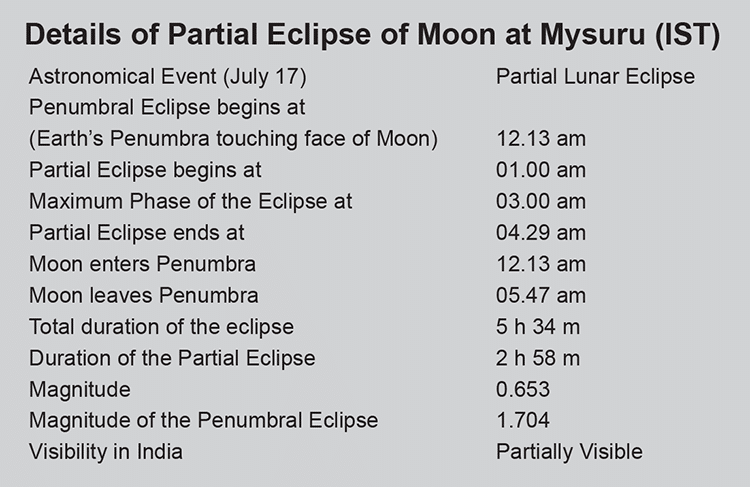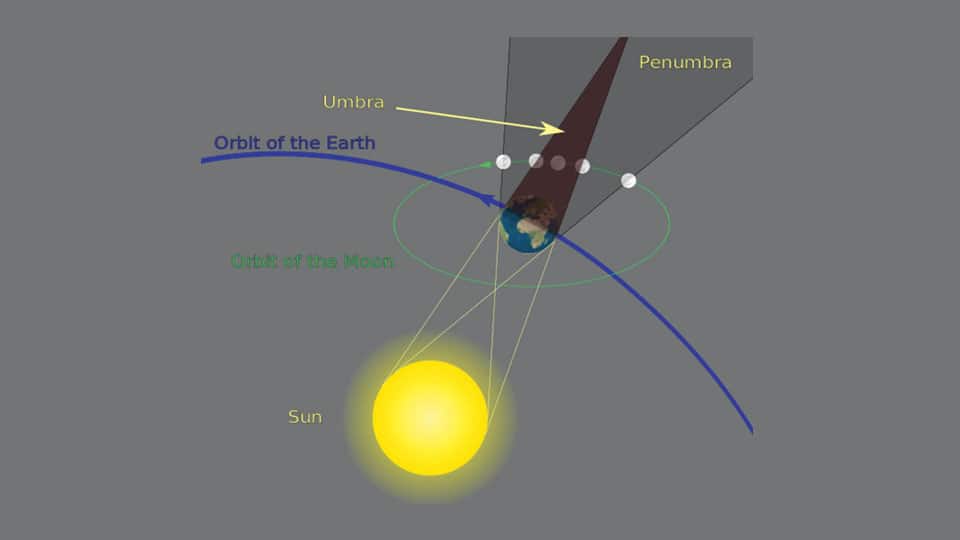By Dr. S.A. Mohan Krishna, Observational Astronomer
The most amazing and evident astronomical event in the sky is an ‘Eclipse.’ None can forget the mesmerising Supermoon, Bloodmoon, Total Lunar Eclipse that occurred on January 31 last year! This astronomical occurrence has been memorable and millions witnessed this spectacular spectacle. Analogously, last year on July 27 – 28, Indians were really privileged to witness a regular longest duration ‘Total Lunar Eclipse’ of this century. But this year, Mysureans are extremely privileged to witness a Penumbral Partial Lunar Eclipse on July 17, since it is visible from all parts of India. This eclipse will be visible in the region covering Europe, Asia, Australia, Africa, Northern and Southern America and New Zealand.
Lunar Eclipses, which may be total or partial, can occur only at Full Moon when Sun, Earth and Moon are in line. As the Sun is an extended light source, Earth’s shadow has two components — a dark, central Umbra, where the Sun is completely obscured, and a lighter outer Penumbra, within which obscuration is partial.
During a Lunar Eclipse, Moon passes first through penumbra, taking about an hour, moving eastward by its own diameter in this time, to reach western edge of umbra. A Lunar Eclipse occurs when Moon passes through umbral region of the Earth’s shadow and becomes imperceptible.
On July 17, at Mysuru, the beginning, middle and the ending phases of the Partial Eclipse will be clearly visible. The eclipse commences by 1.30 am and ends at 4.29 am. No two Lunar Eclipses are ever quite the same, and although some dismiss them as of less interest than Solar Eclipses — particularly Total Solar Eclipses, where the events centred on totality occur rapidly, in contrast with more stately progress of a Lunar Eclipse — they are fascinating to observe. The main difference from one event to another is the degree to which the totally eclipsed Moon is darkened and how colourful it might be. The level of darkened is often described in terms of Danjon Scale.
The total duration of the Penumbral Lunar Eclipse visible on July 17 is 5 hours 34 minutes. The Moon enters Penumbra at 12.13 am, by analysing penumbral phase; the partial eclipse will commence by 1.30 am and terminate at 04.29 am, also leaves Penumbra at 5.47 am. The greatest phase of the eclipse will eventuate at 3 am. The magnitude of the partial eclipse of Moon is 0.653. There is absolutely no harm in witnessing this astronomical spectacle and could be clearly witnessed by using a reflecting telescope or astral binoculars.

Following first contact, Moon’s more easterly limb will show a growing dark “nick” as it begins to enter the umbra more deeply. At a Total Lunar Eclipse, Moon takes about an hour to become completely immersed in the umbra. To begin with, there is little to see beyond a darkening of part of Moon, but as the eclipsed portion increases, some colour may become evident. The curved edge of umbra may show a slight blue fringe. Refraction of sunlight — particularly at the red end of the spectrum — through Earth’s atmosphere means that umbra is not completely dark. Consequently, Moon does not usually disappear from view; instead, it is dimmed and often takes on a reddish colour, which becomes increasingly apparent as umbral phase advances.
The diameter of Earth’s umbra is thought by some to change in response to solar activity, perhaps decreasing at solar maximum as the upper atmosphere becomes slightly more extended in response to increased ultraviolet and X-ray emissions. Many observers try to measure the precise extent of umbra during eclipses by timing the passage of its edge across identifiable lunar features such as craters. Unless a Lunar Eclipse is very dark, it is usually quite easy to make out the dark Maria, contrasting with the brighter, cratered highlands, with the naked eye.
The shadow’s darkness varies with the amount of cloud, dust and pollution that is suspended in Earth’s atmosphere at the time of eclipse. Occasionally, obscuration is sufficiently dense to make Moon disappear, while at other times, the shadow imparts only a pale rusty hue to the Moon.
The duration of totality in a Lunar Eclipse depends on how nearly centrally the Moon passes through umbra; a central passage gives a maximum of 1 hour 47 minutes. During totality, any lighter border on Moon will appear to move gradually round from westerly to the easterly limb. Totality ends when the Moon’s easterly limb re-emerges into sunlight, and over the next hour or so, the full Moon exits umbra to regain its usual brilliance, thereafter clearing penumbra.
At Mysuru, the best viewing location is from Chamundi Hill. After this year, next time that a Blue Moon passes through Earth’s umbra will be on Dec.31, 2028, and after that, on Jan.31, 2037. Both of these eclipses will be total.
Next Lunar Eclipse can be seen on January 10 – 11, 2020. Next year, worldwide four Lunar Eclipses and two Solar Eclipses can be witnessed. But the most awaited Annular Solar Eclipse falls on Dec.26 of this year. So, do not forget to witness the Lunar Eclipse on July 17.








Recent Comments